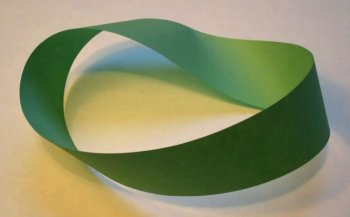One of the most admired loops in science and art, the Möbius strip, has finally been pinned down mathematically. The scientists Eugene L. Starostin and Gert van der Heijden, both at University College London, have figured out how to predict the shape that a Möbius strip of any material will take when it is left at rest, a problem that had confounded researchers for more than 80 years.

A Möbius strip made with paper and tape. Image from Wikipedia, reproduced under the GNU Free Documentation license.
A Möbius strip is easy to make. Simply take a strip of paper, plastic, or any other elastic material, twist one of its ends through 180°, and then glue the two ends together. The shape you end up with has a wonderfully curious property: although it looks more or less like a ring, it has no inside or outside. If you put an ant somewhere in the middle of the strip and get it to start walking in a line parallel to the edge, then after travelling a distance that is twice the length of the paper, it will arrive back at its starting point — without ever crossing the edge of the strip! This also means that, even though the paper strip it was made from has two long edges, the Möbius strip only has one continuous piece of boundary.
Ever since its discovery in the mid-nineteenth century — surprisingly late considering the simplicity of the shape — the strip's strange one-sidedness has fascinated mathematicians and artists alike. M.C. Escher's woodcut, depicting ants on a never-ending walk along the length of the strip, is probably its most famous artistic representation. The strip has even earned a place in the realms of magic, due to its curious ability to resist being cut in half. You can easily try this yourself: cut the strip along the line the ant has walked along, and you'll find that rather than the two separate rings you'd expect, you'll get a single long one with two full twists in it.
Mathematicians are interested in another slightly magical property of the Möbius strip. You can turn any shape drawn on its surface into its mirror image simply by sliding it around. This concept is known as non-orientability, and the Möbius strip is the standard example of a non-orientable surface.
One-sidedness and non-orientability are what's called topological properties of the strip: no matter how you stretch, squeeze or deform the strip, as long as you don't tear it, these properties will stay intact. Topologists simply ignore any deformations that don't involve cutting or tearing, so to them any two Möbius strips, no matter how different in size, exact shape, or material, are one and the same thing.
Starostin and Heijden's new results, published in July in the journal Nature Materials, concern something altogether less abstract. If you take a real-life Möbius strip and put it down to rest on its own, you'll find that it soon settles into a characteristic shape, and that the shape is the same no matter what elastic material the strip is made of. The problem was that until now no-one knew how to give a precise mathematical description of this rest position. There was no way of predicting exactly how a strip of particular dimensions and material would settle down. Given that Möbius strips have a range of real-life applications — they are used in conveyor belts, recording tapes and rollercoasters, for example — this is a real problem: if you want to use a Möbius strip, you need to know how it behaves once it's left on its own.
When a Möbius strip is settling down, it is minimising the energy that was necessary to bend it into its previous non-relaxed position. Starostin and Heijden realised that this equilibrium state, where the energy is minimised, can be described by a set of differential equations which, though known for twenty years, had so far only been published online. Given the strip's aspect ratio — the ratio between its width and length — and the elastic properties of the material it's made of, the researchers were able to use the equations to calculate the exact geometry of the rest position.
During their analysis the researchers spotted that when you increase the strip's aspect ratio, its surface starts getting creased. The creases are similar to those seen in fabrics, crumpled paper, or leaves. Starostin and Heijden believe that their approach could also help understand the behaviour of these materials, even if they don't come in the magical shape of a Möbius strip.